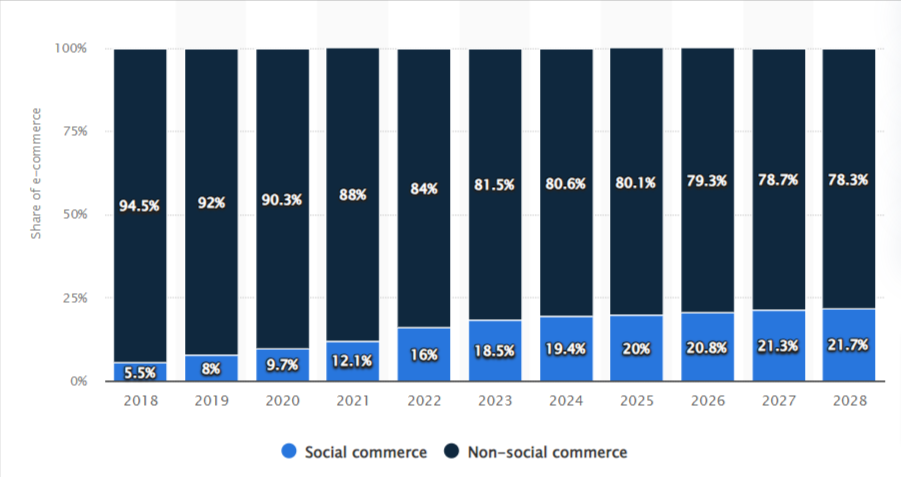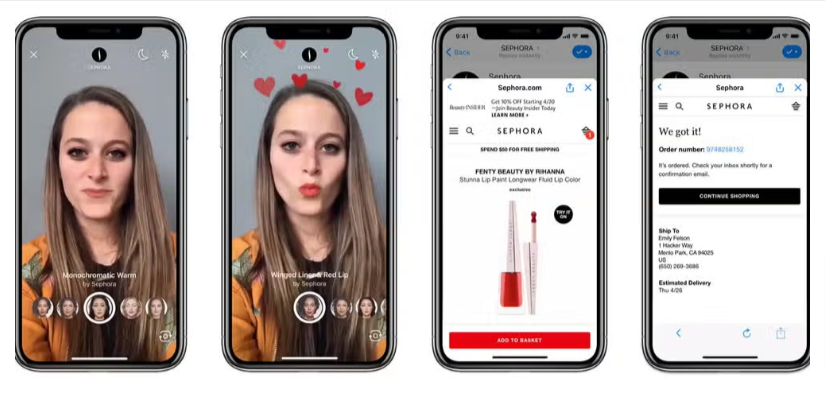Among all the technologies and tools that are playing a role in the growth of the e-commerce industry, none come close to the influence social media platforms have.
Social media platforms have made e-commerce stores even more accessible to customers and bridged the gap between online stores and a global audience. However, e-commerce companies can only benefit from social media platforms if they are updated on the latest trends and leverage them to maximize their reach and revenue.
Over the last decade, the contribution of social commerce in e-commerce has slowly but steadily increased, and e-commerce sellers should take advantage of this steady growth.

That said, let us look at the top social media trends that e-commerce companies should know about and leverage:
Trend 1: Social Commerce Becoming the Norm
With the influence social media platforms have on customers’ purchase decisions, it is not surprising that people can buy or sell products directly on these platforms. According to Statista, the penetration rate of social commerce increased by 23% in 2023 alone. Two trends that drive the popularity of social commerce today are:
Shoppable Posts
Social media platforms like Instagram and Facebook include features that let users make direct purchases from online stores. Retailers can easily showcase their products through posts, and users can use them to shop for products. Integration of such features can facilitate simple and seamless e-commerce purchases on social media platforms.
For instance, Instagram’s Shop feature lets brands showcase their product catalog on the platform to their target audience and helps them expand their reach.
In-App Checkouts
The second trend driving the popularity of social commerce is the in-app checkout option available on social media platforms. In-app checkouts reduce the friction between browsing and buying and enable users to purchase products they discover on social media platforms.
As a result, your online store will have fewer cart abandonments and leverage quicker purchase cycles. TikTok Shop and Facebook Marketplace are great examples of social media facilitating seamless in-app transactions.
Trend 2: Influencer Marketing 2.0
Social media provided the momentum that influencer marketing as a strategy needed to completely blow up in popularity. Individuals and entities with a large subscriber base can influence the way their followers make purchase decisions and even prompt them to use or give up on a brand.
Rise of Micro and Nano Influencers
Brands that want to target a specific customer niche and generate quicker results must consider associating with micro and nano-influencers. Micro-influencers are those with 10000 to 100,000 followers, and nano-influencers are ones with 100 to 10,000 followers.
These influencers are likely to enjoy higher engagement rates and are more likely to post authentic content that can generate conversions for your e-commerce brand.
For instance, if you are a local brand looking to promote your products within a specific city, you will generate better results by partnering with a micro-influencer from the area, than a mega-influencer with a broader target subscriber base.
Authentic Content Over Sponsored Ads
Gone are the days when users couldn’t differentiate between organic and sponsored content. Users now actively seek authentic and non-sponsored content when they come across product recommendations on Facebook or Instagram.
Trend 3: Social Proof & User-Generated Content (UGC)
As customers now have better access to brands through social media, it has also become easier for them to review and rate products. You will find a lot of customers interacting and providing feedback to brands on popular social media platforms.
Importance of Customer Reviews & Testimonials
A good e-commerce brand should know to leverage any reviews or testimonials customers leave on their social media platforms and showcase the positive ones to motivate potential customers. Brand showcase and leverage reviews to create trust among potential buyers and drive more purchases.
Leveraging UGC for Organic Growth
When utilized properly, user-generated content (UGC) can perform better than some of the most carefully crafted influencer and affiliate marketing campaigns. User-generated content can be a great source of content when you want to facilitate organic growth for your brand.
For instance, customers raving about how you provide the cheapest international shipping only makes your brand look good and should be reposted. Hence, you must encourage your customers to leave reviews for their purchases.
For instance, Slack, the popular business communication app leverages Instagram to promote customer testimonials:

Trend 4: Live Shopping and Real-Time Engagement
Live shopping combines the best parts of live-streaming and shopping and refers to brands showcasing products on live video for customers to interact with and purchase. Objectively, live shopping is a great way for retailers to mimic the in-store experience for an online customer base.
Live Stream Shopping Events
Many brands now live stream shopping events allowing them to showcase some of the best products from their catalog to their audience. Platforms like Instagram, YouTube, and TikTok facilitate these live events for retailers who want to interact and sell directly to their customers.
For instance, customers will get all the sales service they get at a brick-and-mortar store, helping them make purchase decisions easily.
Real-Time Customer Interactions
Live shopping also lets the customers interact with the brand directly and ask any questions they may have so they make an informed decision. These live shopping sessions also give customers access to live product demos and facilitate feedback.
Trend 5: Social Media as a Customer Service Channel
One of the most common ways e-commerce brands today use social media is as an extended arm of their customer service team. Considering your target audience is likely to be on social media, this is a smart choice for two reasons:
Immediate Response to Customer Queries
Social media eliminates the gap between brands and customers by allowing brands to provide instant replies to customers. Social media makes it easier for customers to get in touch with brands and seek support through real-time messaging. As a result, brands offering customer service on social media report higher customer satisfaction and faster resolution for issues and problems.

Public Engagement on Social Platforms
If you get many website visitors to your online store but do not translate into customers, social media can help you increase engagement. Not only this, by dedicating personnel to manage your social media account, you can provide quick and personalized responses to customers thus boosting their satisfaction and loyalty towards your brand.
Trend 6: The Rise of Social Media Marketplaces
E-commerce companies can require a lot of resources and personnel when launching a full-fledged online marketplace. But with social media, you already have the foundation ready, and only have to focus on taking your product catalog online.
Consolidation of Social Media and E-commerce
With the emergence of social media marketplaces like TikTok Shop and Facebook Marketplaces, e-commerce companies could leverage an alternate medium to sell their products. Some benefits you can get by leveraging social media marketplaces are lower barriers to entering and ease of scaling up.
Trend 7: AR/VR in Social Media for E-commerce
Augmented Reality (AR) and Virtual Reality (VR) have been a part of marketing strategies for a while. However, it is only recently that these technologies have been packaged with social media platforms to elevate the standard online shopping experience.
Virtual Try-Ons
One of the perks of integrating AR into social media is enabling virtual try-on features for customers. Using AR, social media lets customers try products virtually and get an idea of how the product will look before buying it. This is great for certain product categories including apparel, makeup, footwear, etc.
For instance, Sephora leverages AR features on Instagram that allow users to try out their makeup products virtually before buying them.

Immersive Shopping Experiences
Some brands also opt for virtual storefronts helping them craft highly immersive shopping experiences. These storefronts have virtual shelves and 3D product displays so the customer can get the best possible view of your product before purchasing it.
Trend 8: Data-Driven Personalization on Social Media
Personalization is one of the biggest advantages to come out of social media. With the volume of data customers feed into social media algorithms simply by being active and engaging with pages and individuals on the platform, brands can present tailored content to them and increase the odds of hitting the bull’s eye.
AI-Powered Personalization
Artificial Intelligence (AI) and algorithms empowered by the technology are key drivers of personalization on social media platforms like Instagram and TikTok. Brands can use AI to create and circulate personalized content and recommend products on their website to customers who have expressed interest in similar ones.
For example, Instagram and Facebook show tailored product recommendations to individual users based on their past searches and engagement with brands.
Benefits of Hyper-Personalization
AI empowers social media platforms to hyper-personalize content shown to individual users, helping brands show tailored content to highly engaged or valuable users who are most likely to become customers. There are two main advantages you can get from hyper-personalization on social media:
- Increased Conversion Rate: Tailored content is more likely to convince highly engaged users and convert them into customers. So by harnessing the power of hyper-personalization, brands can enjoy an increased conversion rate.
- Better Customer Retention: Brands can also run impactful Instagram and Facebook retargeting campaigns by reminding them of abandoned carts or incomplete orders and even showing product recommendations based on past orders to retain existing customers.
Trend 9: Integrating Sustainable and Ethical Practices into Social Commerce
The word of this decade is sustainability with online consumers becoming increasingly aware of the importance of sustainable and ethical social commerce practices. They expect brands to uphold those practices and choose brands that do over the ones that don’t.
Conscious Consumerism
While social media has boosted awareness about sustainable and ethical social commerce practices, it has also doubled up as a communication tool for brands to showcase their efforts. Brands can create content around sustainable practices and ethical sourcing practices that they follow, and attract conscious consumers.

Promoting Transparency and Accountability
The modern consumer believes in holding the brands they shop from accountable for the practices and values they promote. They gravitate towards brands that openly communicate their values and showcase these values in their practices.
For instance, many brands showcase transparency by showcasing their financial performance by leveraging a good balance sheet and income statement template to post on their website.
Conclusion
As social media gains even more momentum in 2025, brands must identify the key trends associated with the platforms that they are utilizing. E-commerce companies can leverage popular trends like social commerce, live shopping, and influencer marketing to boost their revenue. They can also tailor product recommendations to customers based on their evolving preferences.
Start implementing these trends to stay ahead in the competitive e-commerce world.




